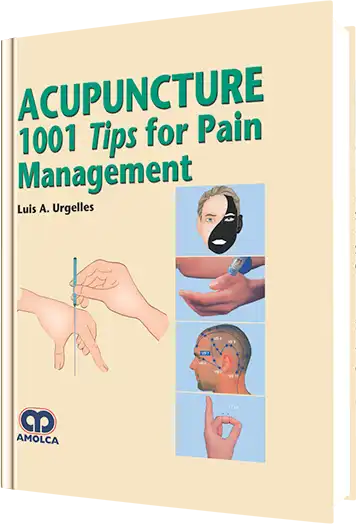
Acupuncture 1001 Tips For Pain Management
Anestesiología - Medicina General
160,00 USD ($)
Descripción
Ficha Técnica
9789588816418
A color - Formato: 21,5 x 28 cm
Dura
202
2015
0
1.26 kg
| Part 1.- Introduction Part 2.- The yang-yin and five elements theories 1. The Yang-Yin Theory. 1.1. “Full Yang” State. 1.2. “Full Yin” State. 1.3. “Empty Yang” State. 1.4. “Empty Yin” State”. 2. The Five Elements Theory. 2.1. Formation Cycle. 2.2. Mother - Child relationship. 2.3. Destruction Cycle. 2.4. Conqueror - conquered relationship. 2.5. Relationship between the Five Elements and the internal organs. 2.6. Hollow organs (Yang) and Solid organs (Yin) Part 3.- Meridians and Points 3. Acupunture Points. 3.1. Measurements for the location of Acupuncture Points. 3.2. The Meridians and their relation with the energy flow. 4. Anatomical Pathway of the Meridians. 4.1. Lung Meridian (L) (-) YIN. 4.2. Large Intestine Meridian (LI) (+) YANG. 4.3. Stomach Meridian (ST) (+) YANG. 4.4. Spleen Meridian (SP) (-) YIN. 4.5. Heart Meridian (H) (-) YIN. 4.6. Small Intestine Meridian (SI) (+) YANG. 4.7. Bladder Meridian (BL) (+) YANG. 4.8. Kidney Meridian (K) (-) YIN. 4.9. Pericardium Meridian (PC) (-) YIN. 4.10. Triple Burner Meridian (TB) (+) YANG. 4.11. Gall Bladder Meridian (GB) (+) YANG. 4.12. Liver Meridian (LV) (-) YIN. 4.13. Governing Vessel Meridian (GV) (+) YANG. 4.14. Conception Vessel Meridian (CV) (-) YIN. 5. Anatomical location of the Acupuncture points. 5.1. Lung Meridian (L) (-) YIN. 5.2. Large Intestine Meridian (LI) (+) YANG. 5.3. Stomach Meridian (ST) (+) YANG. 5.4. Spleen Meridian (SP) (-) YlN. 5.5. Heart Meridian (H) (-) YIN. 5.6. Small Intestine Meridian (SI) (+) YANG. 5.7. Bladder Meridian (BL) (+) YANG. 5.8. Kidney Meridian (K) (-) YIN. 5.9. Pericardium Meridian (PC) (-) YIN. 5.10. Triple Burner Meridian (TB) (+) YANG5.11. Gall Bladder Meridian (GB) (+) YANG5.12. Liver Meridian (LV) (-) YIN5.13. Governor Vessel Meridian (GV) (+) YANG5.14. Conception Vessel Meridian (CV) (-) YIN5.15. Extraordinary Points Part 4.- List of the names of the points of acupuncture 6. Names of Acupuncture Points. 6.1. Lung (L). 6.2. Large Intestine (LI). 6.3. Stomach (ST). 6.4. Spleen (SP). 6.5. Heart (H). 6.6. Small Intestine (SI). 6.7. Bladder (BL). 6.8. Kidney (K). 6.9. Pericardium (PC). 6.10. Triple Burner (TB). 6.11. Gall Bladder (GB). 6.12. Liver (LV). 6.13. Governor Vessel (GV). 6.14. Conception Vessel (CV) Part 5.- Acupuncture Techniques 7. Techniques and Manipulation. 7.1. Acupuncture Techniques. 7.2. The needles. 7.3. Manipulation of the patient Part 6.- Pain 8. Neurophysiological Mechanisms of Pain. 8.1. Anatomy of the Nervous System. 8.2. Action Potential. 8.3. Pain Pathway. 8.4. Somatic Senses. 8.5. Pain and inflammation. 8.6. Dentistry Pain. 8.7. Referred pain. 8.8. Diffuse pain. 8.9. Radiated pain. 8.10. Phantom pain (Ghost pain). 8.11. Psychogenic pain. 8.12. Trigger Point. 8.13. Acute vs. Chronic Pain. 8.14. Nociceptive and Neuropathic pain. 8.15. Analgesia vs. Anesthesia Part 7.- Analgesic Mechanisms of Acupuncture Part 8.- Acupuncture Analgesics in Surgerys 9. Acupuncture Analgesic in Surgery. 10. Acupuncture Analgesic in Experimental Surgery Part 9.- Acupuncture in oncologya 11. Acupuncture Analgesic in oncology Part 10.- Therapeutic indications 12. Practical Approaches of PHYPANA and PRM in your daily practic. 12.1. Stem Cell Therapy for Pain. 12.2. Complications. 13. Therapeutic guide. 13.1. Tip: Anxiety. 13.2. Tip: Bronchial asthma. 13.3. Tip: Conjunctivitis. 13.4. Tip: Constipation. 13.5. Tip: Cough. 13.6. Tip: Diarrheas. 13.7. Tip: Epicondylitis. 13.8. Tip: Enuresis. 13.9. Tip: Epilepsy. 13.10. Tip: Facial paralysis. 13.11. Tip: Fatigue / Fibromyalgia. 13.12. Tip: FLU / Cold. 13.13. Tip: Hypertension. 13.14. Tip: Insomnia. 13.15. Tip: Knee (Osteoarthritis). 13.16. Tip: Leukopenia. 13.17. Tip: Low back pain and ischialgia. 13.18. Tip: Migraine. 13.19. Tip: Obesity. 13.20. Tip: Osteoarthritis (Cervical). 13.21. Tip: Palliative care:. 13.22. Tip: PMS. 13.23. Tip: Rhinitis. 13.24. Tip: Shoulder Pain. 13.25. Tip: Smoking. 13.26. Tip: Stress. 13.27. Tip: Temporomandibular Joint Disorder (TMJ). 13.28. Tip: Thoracic Osteoarthritis. 13.29. Tip: Tonsillitis (Chronic). 13.30. Tip: Tooth ache. 13.31. Tip: Torticollis (Wryneck). 13.32. Tip: Trigeminal Neuralgia. 13.33. Tip: Vomit. 13.34. Acupuncture in Surgical procedure Appendix. References. Glossary. Index. Acronyms and Abbreviations. |
Libros relacionados







Comentarios recientes